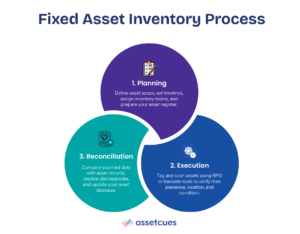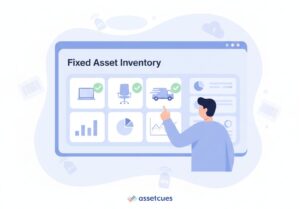Introduction
Accurate fixed asset inventory practices ensure smooth audits and prevent financial chaos. Many firms face “ghost assets”—items recorded but no longer existing—causing compliance and valuation risks. Therefore, companies conduct annual physical counts to align records with actual assets and meet IFRS or GAAP standards. In short, a structured process—plan, count, and reconcile—keeps your books accurate and audit-ready.
<<“Explore our detailed guide on fixed asset inventory management.”>>

Planning Phase: Setting the Stage for a Successful Inventory
Proper planning sets the stage for an accurate fixed asset count. Define the scope, assign the team, set a schedule, and prepare all data and tools so the inventory runs smoothly with no surprises.
-
Define Inventory Scope and Objectives
Begin by defining which assets and locations fall within your inventory scope. Decide between a full “wall-to-wall” count or a focused “file-to-floor” audit to verify listed items. Set clear objectives—reconcile records, detect ghost assets, and update details across all categories. When records are outdated, start with a wall-to-wall count; otherwise, periodic audits work efficiently.
-
Assemble the Inventory Team and Assign Roles
Form a dedicated inventory team with clearly defined roles and responsibilities. Train members on procedures, asset categories, and inventory tools for accuracy. Ensure objectivity by involving independent verifiers or using cross-checks during counting. Avoid having asset custodians verify their own items to maintain credibility.
-
Schedule and Communicate the Inventory Plan
Choose an appropriate time for the physical count and plan it early. Many organizations align it with year-end or low-activity periods to reduce disruption. Once scheduled, share the plan across departments and freeze asset movements to prevent misplaced items. Also, arrange access to all areas beforehand and explain how the inventory supports financial accuracy and compliance, ensuring staff cooperation and process efficiency.
Decide how often to conduct future inventories to maintain accuracy and control. Perform at least one full annual count, and inspect high-value or mobile assets more frequently, such as quarterly. Large, static assets can be verified once a year for efficiency. Finally, schedule the next inventory in advance so it becomes a routine process, not a reactive task.
-
Prepare Asset Data and Tools in Advance
Before starting the count, update asset records by removing disposed items and adding new ones. Standardize details so every asset has an ID, location, and key information, and plan to capture any missing data during the count. Provide a clear procedures guide to ensure consistency across the team. Finally, gather all required tools—asset tags, scanners or mobile apps, and basic supplies—to enable accurate, real-time data collection.
Execution Phase: Conducting the Physical Asset Count
With planning done, it’s time to carry out the physical asset inventory. The team goes on-site to verify each asset. Focus on accuracy, completeness, and efficiency – ensure every asset is accounted for and none are counted twice. Use technology where you can to speed up the count without sacrificing accuracy.
-
Use a Structured Approach (Wall-to-Wall vs. File-to-Floor)
Work systematically with a clear counting strategy to maintain accuracy. A file-to-floor audit begins with the asset register and verifies each listed asset physically, marking found items and flagging missing ones. This approach works best when records are current. A wall-to-wall inventory, on the other hand, covers every asset on-site—tagging unlisted items and ensuring no asset is missed, though it requires more time.
In practice, many organizations use a hybrid approach for thorough verification. During a file-to-floor count, record any extra assets found to cover unlisted items. Likewise, after a wall-to-wall count, compare results with the register to identify missing recorded assets. The best practice is to verify both ways, ensuring every listed asset exists physically and every physical asset appears in the system.
-
Verify, Tag, and Scan Each Asset
Follow a consistent process for every asset to maintain accuracy and traceability. First, identify and verify each asset using its ID or tag, confirming details like location and condition. Next, tag unmarked assets with a unique barcode or RFID label and record the new ID. Then, mark assets as “found” in your system and log any updates. For unexpected items, assign temporary IDs, and for incorrect records, note corrections to ensure complete data integrity.
Use real-time data capture if possible. A mobile asset inventory app lets you scan assets with a smartphone and input details (even attach photos or notes) on the spot. This avoids later re-entry of data and reduces errors. If you are using paper lists, be sure to enter and reconcile that information in the system promptly (ideally by the end of each day) so nothing gets lost.
For a deeper understanding of how a digital inventory management platform supports this workflow, read our Beginner’s Guide to Asset Inventory Management System.
Pro Tip: Using technology can dramatically speed up your asset count and improve accuracy. Digital tagging and scanning can reduce audit time by nearly 70% while minimizing human errors. Scanning barcodes or RFID tags is far faster and more precise than manual entry, cutting data errors by about 43%. In short, automation streamlines inventory counts, making them both efficient and reliable.
-
Conduct Quality Control During Counting
Build in quality control. Team members can work in pairs or do spot audits to double-check counts, and they should log any issues or anomalies immediately for later reconciliation. Mark assets once counted (e.g. with a sticker) to avoid duplicates. Always follow safety protocols and use proper PPE where required.
By the end of the execution phase, you should have a complete and categorized record of results. This includes all verified assets, any missing items, and newly discovered assets found during the count. Also, note any discrepancies for review. In short, every asset is now accounted for, creating a clear foundation for the reconciliation phase.
Reconciliation & Improvement Phase: Ensuring Accuracy and Continuous Improvement
After counting, it’s time to reconcile the results with your records and fix any discrepancies. This step is crucial for accurate financials and provides lessons to improve your asset management process. Once everything is reconciled and updated, you can implement improvements so that future inventories go even better.
-
Reconcile Physical Count Results with Asset Register
Compare the physical count results with your fixed asset register to identify differences. Record discrepancies such as missing assets, extra items, or mismatched details between records and reality. Focus first on critical issues, like high-value or essential equipment, before addressing minor inconsistencies. This ensures a structured and effective reconciliation process.
-
Investigate and Resolve Discrepancies Promptly
Investigate every discrepancy and take corrective action immediately. If an asset is missing, verify with records and staff, then remove it if confirmed gone. For extra assets, add them to the register with complete details, and correct any inaccurate data. Always document resolutions to maintain a clear audit trail, and address issues promptly while information is still fresh.
After resolving all discrepancies, update your records and financials to reflect accurate data. Write off missing assets so they’re removed from the books, and add newly found items to the register for proper depreciation tracking. Correct any updated details such as locations, status, or insurance coverage. Finally, coordinate with the finance team to align changes with the general ledger, ensuring your books fully match real-world assets.
-
Reporting the Inventory Results
Prepare a detailed inventory report for management and audit review. Include the scope, dates, team members, and key findings such as total assets verified, missing items, and new additions. Summarize major discrepancies and the actions taken to resolve them, including register updates or write-offs. Finally, ensure management reviews and approves the report to confirm accuracy and accountability.
-
Implement Improvements and Next Steps
Use lessons learned to strengthen your asset management process and prevent repeat issues. Address root causes—like delayed tagging or outdated tracking tools—to improve accuracy. Resolve any bottlenecks noted during the count and conduct spot-checks or cycle counts in high-risk areas more often. Update policies and training to reinforce improvements, and schedule the next inventory early. Treat your checklist as a living document to drive continuous, efficient improvement.
Frequently Asked Questions (FAQ)
Q: How do I conduct a physical inventory of fixed assets?
A: Conducting a physical fixed asset inventory involves three clear phases: planning, execution, and reconciliation. Start by defining the scope, forming a trained team, and preparing updated records and tools. Then, perform an on-site count—locate, tag, and verify every asset while noting missing or new ones. Finally, compare results with records, resolve discrepancies, and update financials so your books accurately reflect reality.
Q: What are the best practices for fixed asset inventory management?
A: Effective fixed asset inventory management relies on regular counts, clear procedures, and smart tools. Use unique tags and scanners to cut errors and improve accuracy. Combine wall-to-wall and record-to-floor checks for full verification, then update records promptly. Continuously refine processes to maintain a reliable, audit-ready asset register.
Q: What steps should be in our fixed asset inventory procedures?
A: A strong fixed asset inventory procedure covers three stages: pre-inventory, inventory, and post-inventory. First, plan by updating records, defining scope, assigning roles, and scheduling the count. Next, identify, tag, and record each asset, noting any missing or new items. Finally, reconcile and update the register, resolve discrepancies, and prepare a report. Clearly define responsibilities and exception handling to ensure a smooth, consistent process.
Q: How can we speed up the fixed asset counting process without losing accuracy?
A: Use technology and organization to make inventories faster and more accurate. Barcode or RFID scanning can cut counting time by up to 70% while ensuring precision. Equip teams with mobile apps or scanners for real-time updates and organize counts by zones or departments for efficiency. Prepare in advance by cleaning data and labeling all assets, then perform spot checks for quality. In short, automation, preparation, and teamwork drive faster, reliable results.
Q: Do we have a checklist for a fixed asset inventory audit?
A: Yes — a fixed asset inventory checklist is essential for smooth audits and annual counts. It covers every phase, from planning and team setup to tagging, counting, and reconciliation. Customize it to your organization’s needs, including scope, roles, tools, and verification steps. A checklist ensures no task is missed and provides auditors with proof of a structured, compliant process.
Conclusion and Next Steps

Performing a fixed asset physical count may sound daunting, but with the right process and best practices it becomes manageable and rewarding. Through careful planning, modern technology, and strict accountability, you can achieve near 100% accuracy in your fixed asset records. The payoff is well worth it: cleaner financial statements, better compliance, and fewer “lost” assets.
Remember that fixed asset inventory management is not a one-time task but an ongoing discipline. Make it part of your annual (or quarterly) routine, and refine your approach each time using what you’ve learned. The checklist and tips we’ve discussed will help ensure your next inventory count is faster and more accurate than the last.
Ready to simplify your fixed asset inventories? Download our free Fixed Asset Inventory Checklist and tailor it to your needs. If tracking thousands of assets feels daunting, our B2B software can help. It integrates barcode/RFID technology and real-time syncing, reducing audit time and cost by up to 70%. Book a demo to see how easily you can manage your next count with speed and accuracy. Don’t let ghost assets linger—take control of your inventory today!











